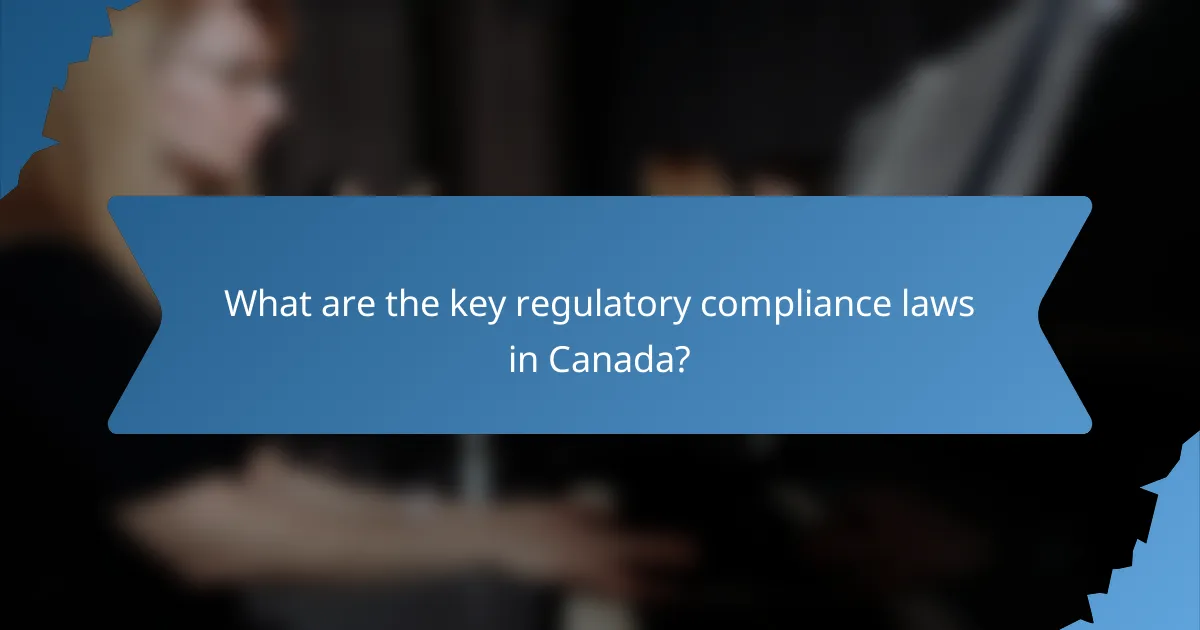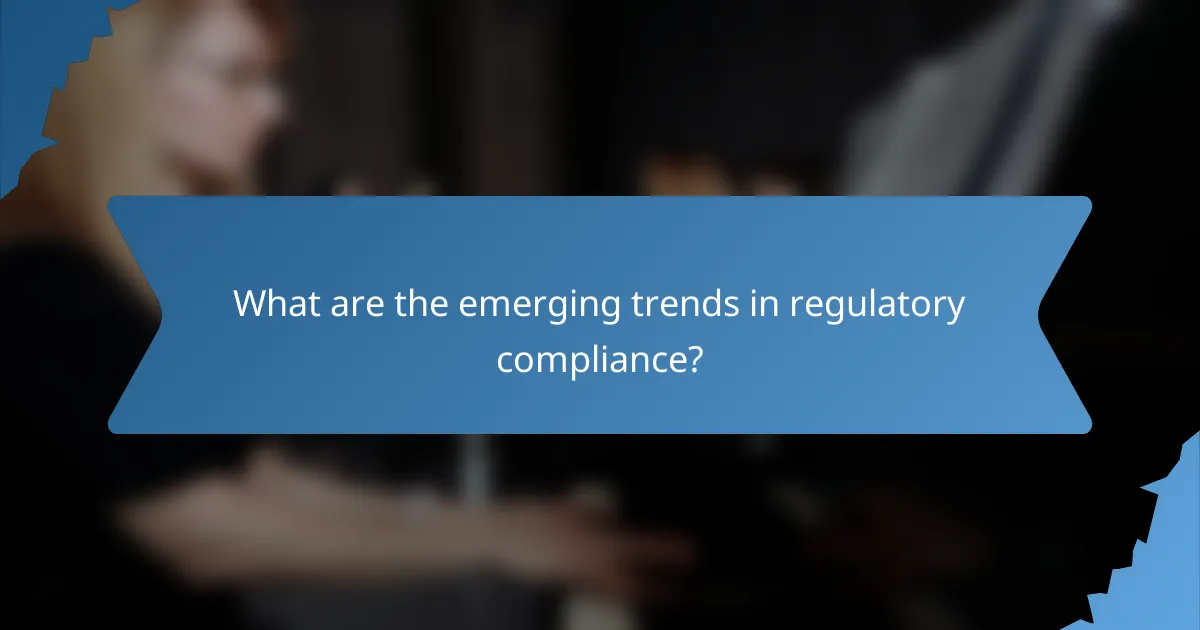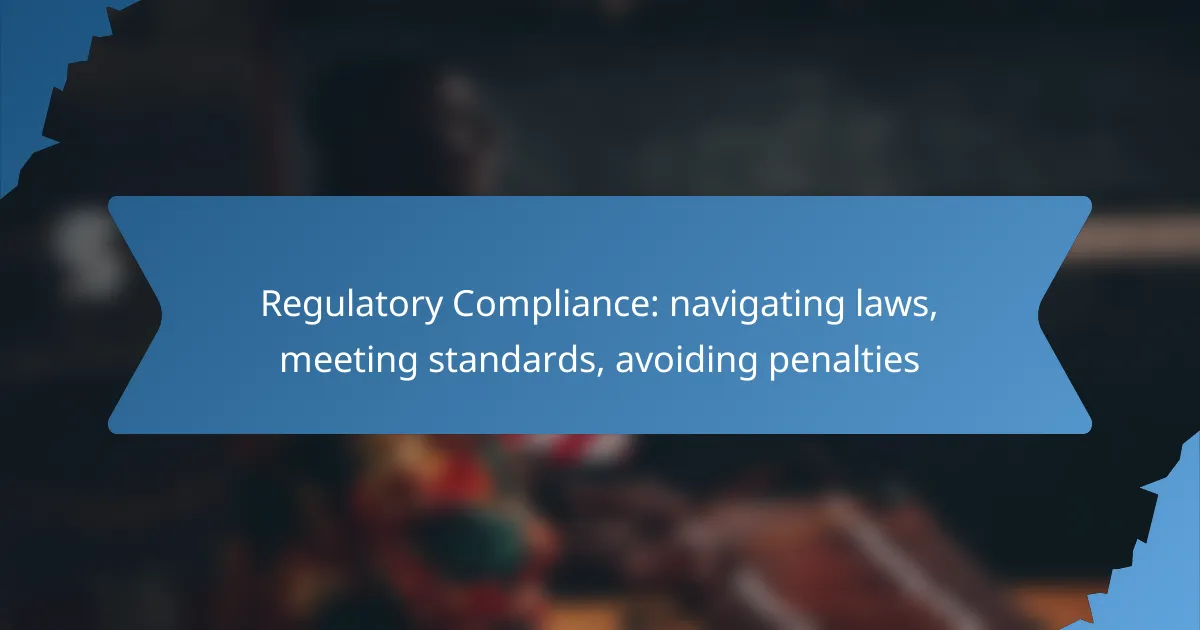Regulatory compliance is essential for businesses to navigate the complex landscape of laws and standards that govern their operations. In Canada, understanding key regulations related to data protection, workplace safety, and environmental standards is crucial to avoid significant penalties and maintain a good reputation. By implementing structured compliance strategies, organizations can effectively manage their responsibilities and ensure adherence to legal requirements.

What are the key regulatory compliance laws in Canada?
Key regulatory compliance laws in Canada include various statutes that govern business operations, data protection, workplace safety, environmental standards, and electronic communications. Understanding these laws is crucial for organizations to avoid penalties and maintain compliance.
Canada Business Corporations Act
The Canada Business Corporations Act (CBCA) regulates the incorporation and governance of businesses in Canada. It outlines the responsibilities of directors and officers, shareholder rights, and the process for corporate governance. Companies must adhere to the CBCA to ensure legal compliance and protect stakeholder interests.
To comply with the CBCA, businesses should maintain accurate records, hold regular meetings, and file annual returns. Failure to comply can result in fines or loss of corporate status.
Personal Information Protection and Electronic Documents Act
The Personal Information Protection and Electronic Documents Act (PIPEDA) governs how private sector organizations collect, use, and disclose personal information in Canada. It mandates that organizations obtain consent and implement safeguards to protect personal data.
Organizations must develop clear privacy policies and ensure employees are trained on data protection practices. Non-compliance can lead to significant penalties and reputational damage.
Occupational Health and Safety Act
The Occupational Health and Safety Act (OHSA) establishes standards for workplace safety and health in Canada. It outlines the responsibilities of employers to provide a safe working environment and the rights of workers to refuse unsafe work.
Employers should conduct regular safety audits, provide training, and maintain clear communication about safety protocols. Ignoring OHSA requirements can result in fines and increased liability for workplace injuries.
Environmental Protection Act
The Environmental Protection Act (EPA) sets the framework for environmental protection in Canada, regulating pollutants and hazardous substances. Organizations must comply with environmental assessments and reporting requirements to minimize their ecological impact.
Companies should implement sustainable practices and regularly review their environmental policies. Non-compliance with the EPA can lead to substantial fines and legal action.
Anti-Spam Legislation
Canada’s Anti-Spam Legislation (CASL) regulates the sending of commercial electronic messages (CEMs) and aims to protect consumers from spam. Organizations must obtain consent before sending CEMs and provide clear opt-out options.
To comply with CASL, businesses should maintain accurate records of consent and ensure their marketing practices align with the legislation. Violations can result in hefty fines and damage to brand reputation.

How can businesses ensure compliance with Canadian regulations?
Businesses can ensure compliance with Canadian regulations by implementing a structured approach that includes regular audits, employee training, expert consultations, and effective management systems. These strategies help organizations navigate complex laws and maintain adherence to standards, ultimately avoiding penalties.
Regular compliance audits
Conducting regular compliance audits is essential for identifying gaps in adherence to regulations. These audits can be scheduled annually or semi-annually, depending on the size and complexity of the business. They should cover all relevant areas, including financial practices, safety standards, and environmental regulations.
During an audit, businesses should assess their policies, procedures, and operational practices against applicable laws. This proactive approach allows for timely corrections and reduces the risk of non-compliance penalties.
Employee training programs
Implementing employee training programs is crucial for fostering a culture of compliance within the organization. Training should cover relevant laws and regulations, as well as internal policies and procedures. Regular workshops and refresher courses can help keep employees informed about changes in regulations.
Consider tailoring training sessions to specific roles within the company to enhance relevance and engagement. This targeted approach ensures that employees understand their responsibilities and the importance of compliance in their daily tasks.
Consulting with legal experts
Consulting with legal experts is a strategic move for businesses seeking to navigate the complexities of Canadian regulations. Legal professionals can provide insights into specific laws, help interpret regulations, and advise on best practices for compliance. Engaging with experts can also assist in risk assessment and mitigation strategies.
Establishing a relationship with a legal advisor familiar with your industry can prove invaluable. They can offer ongoing support and updates on regulatory changes that may impact your operations.
Implementing compliance management systems
Implementing compliance management systems streamlines the process of maintaining regulatory adherence. These systems can include software solutions that track compliance activities, document management, and reporting features. They help ensure that all compliance-related tasks are organized and easily accessible.
When selecting a compliance management system, consider factors such as scalability, user-friendliness, and integration with existing processes. A well-chosen system can significantly reduce the administrative burden and enhance overall compliance efforts.

What are the penalties for non-compliance in Canada?
In Canada, penalties for non-compliance can include significant fines, legal actions, loss of business licenses, and damage to reputation. Understanding these consequences is crucial for businesses to maintain compliance with applicable laws and regulations.
Fines and monetary penalties
Fines for non-compliance in Canada can vary widely depending on the nature of the violation and the governing body involved. For instance, environmental violations may incur fines ranging from thousands to millions of Canadian dollars. Businesses should be aware that repeated offenses can lead to increased penalties.
In some cases, regulatory bodies may impose daily fines for ongoing non-compliance, which can accumulate quickly. It is essential for businesses to regularly review their compliance status to avoid these financial repercussions.
Legal action and lawsuits
Non-compliance can lead to legal actions, including lawsuits from affected parties or enforcement actions by regulatory agencies. These legal proceedings can be costly and time-consuming, diverting resources from core business activities. Companies may face class-action lawsuits if multiple individuals are affected by their non-compliance.
Additionally, legal actions can result in court-ordered remedies, which may include compensatory damages or injunctions requiring compliance. Businesses should proactively address compliance issues to mitigate the risk of legal disputes.
Business license revocation
In Canada, regulatory authorities have the power to revoke business licenses for serious compliance failures. This can effectively shut down operations, leading to significant financial losses. Businesses must ensure they meet all regulatory requirements to maintain their licenses.
License revocation can also affect a company’s ability to operate in the future, as reapplying for a license may involve extensive scrutiny and additional costs. Regular compliance audits can help prevent such drastic measures.
Reputational damage
Non-compliance can severely damage a company’s reputation, leading to loss of customer trust and loyalty. Negative publicity from compliance failures can deter potential clients and partners, impacting long-term profitability. Businesses should prioritize transparency and ethical practices to build and maintain a positive reputation.
Reputational damage can have lasting effects, as customers may choose competitors over a company known for compliance issues. Engaging in proactive communication and demonstrating commitment to compliance can help mitigate reputational risks.

What frameworks help in navigating compliance?
Frameworks such as ISO 9001 and ISO 27001 provide structured approaches to regulatory compliance, helping organizations meet legal standards and avoid penalties. These frameworks outline best practices and processes that enhance quality management and information security, respectively.
ISO 9001 Quality Management
ISO 9001 focuses on establishing a quality management system (QMS) that ensures consistent product and service quality. Organizations implementing this framework typically engage in continuous improvement processes, customer satisfaction assessments, and regular audits to maintain compliance.
Key steps include defining quality objectives, documenting processes, and conducting internal audits. For example, a company might set a goal to reduce product defects by a certain percentage over a year, using customer feedback as a benchmark.
Common pitfalls include inadequate training for staff and failure to engage all levels of the organization. To avoid these, ensure that everyone understands their role in the QMS and provide ongoing training and resources.
ISO 27001 Information Security
ISO 27001 provides a framework for managing information security risks, helping organizations protect sensitive data from breaches and comply with regulations. This standard emphasizes the importance of risk assessment, security controls, and continuous monitoring.
Organizations should start by identifying information assets and assessing potential risks. For instance, a business might implement encryption for sensitive customer data and conduct regular security audits to ensure compliance with the standard.
To maintain compliance, organizations should avoid neglecting employee training and awareness programs. Regularly updating security policies and conducting drills can help reinforce a culture of security within the organization.

How to stay updated on regulatory changes in Canada?
To stay informed about regulatory changes in Canada, regularly engage with reliable sources that provide updates on laws and compliance standards. This proactive approach helps businesses avoid penalties and ensures adherence to evolving regulations.
Subscribe to regulatory newsletters
Subscribing to regulatory newsletters is an effective way to receive timely updates on changes in laws and compliance requirements. Many government agencies and legal firms offer newsletters that summarize recent developments and provide insights into their implications.
Look for newsletters that focus specifically on your industry to ensure the information is relevant. For instance, sectors like finance, healthcare, and environmental services often have tailored newsletters that highlight pertinent regulations.
Join industry associations
Joining industry associations can provide valuable resources and networking opportunities to stay updated on regulatory changes. These organizations often host events, webinars, and discussions that focus on compliance issues affecting their members.
Membership typically includes access to exclusive reports and publications that analyze regulatory trends. Engaging with peers in your industry can also help you share insights and strategies for navigating compliance challenges.
Attend compliance workshops
Attending compliance workshops is a hands-on approach to understanding regulatory changes. These workshops often feature experts who discuss recent updates and offer practical guidance on implementing necessary changes within your organization.
Look for workshops that are specific to your sector or focus on particular regulations relevant to your business. Participating in these sessions can enhance your knowledge and provide actionable steps to ensure compliance.

What are the emerging trends in regulatory compliance?
Emerging trends in regulatory compliance focus on increased automation, data privacy, and environmental sustainability. Organizations are adopting technology to streamline compliance processes while adapting to evolving regulations that prioritize consumer protection and corporate responsibility.
Increased Automation in Compliance Processes
Automation is becoming essential in regulatory compliance, allowing businesses to efficiently manage complex requirements. By utilizing software solutions, companies can automate data collection, reporting, and monitoring, reducing the risk of human error and ensuring timely compliance.
For example, many firms are implementing compliance management systems that integrate with existing operations, enabling real-time tracking of regulatory changes. This proactive approach helps organizations stay ahead of compliance deadlines and avoid potential penalties.
Focus on Data Privacy Regulations
Data privacy is a critical area of focus for regulatory compliance, driven by regulations like the GDPR in Europe and CCPA in California. Organizations must prioritize safeguarding personal data and ensure transparency in their data handling practices.
To comply, businesses should conduct regular audits of their data practices, implement robust security measures, and provide clear privacy notices to consumers. Failing to meet these standards can result in substantial fines, often reaching millions of dollars.
Environmental Sustainability Compliance
Environmental sustainability is increasingly influencing regulatory compliance, with many jurisdictions introducing stricter environmental laws. Companies are expected to demonstrate their commitment to sustainability through compliance with regulations related to emissions, waste management, and resource conservation.
Organizations can adopt practices such as conducting environmental impact assessments and setting measurable sustainability goals. Staying compliant not only helps avoid penalties but can also enhance a company’s reputation and appeal to environmentally conscious consumers.
